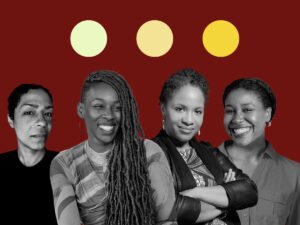
This article introduces a new NPQ series titled Community-Driven Philanthropy. In this series, movement leaders explore what’s possible if philanthropy adopts a reparative model—one which supports the leadership of BIPOC communities, not just by writing grants, but by shifting assets and control over resources to frontline communities.
Whatever you think about the growing role of megadonors in the nonprofit field, the sheer size—often equivalent to the total annual revenue of recipients—of the unrestricted grants that donors such as MacKenzie Scott have made to hundreds of nonprofits has injected a new sense of possibility into the field.
Notably, Scott has infused funds into sectors long overlooked or ignored by other philanthropists and foundations. Her approach has benefited from a rigorous selection process informed and strengthened by advisors with ears to the ground—who have relationships with people on the frontlines of social change work—and by an emphasis on investments that reveal and address inequities in the philanthropic field.
While Scott’s moves have been bold, her underlying assets are generating new revenue even faster than she is giving grant dollars away (at least before this year’s stock market downturn). In light of the country’s growing reparations movements, such revenue generation raises a question: what if, instead of giving away cash, donors transferred ownership of their assets to frontline communities?
Some philanthropists have already done just this. In 1984, Chuck Feeney transferred his shares in Duty Free Shoppers to the Atlantic Philanthropies, which was able to deploy over $8 billion to address various pressing social problems sooner rather than later. Earlier this year, Mackenzie Scott donated two of her mansions, together worth $55 million, to the California Community Foundation, supporting the foundation’s efforts to expand affordable housing in Los Angeles and immigration programs.
For philanthropy to sustainably and forcefully address a growing class and racial wealth divide, such transfers of wealth must become common.
Towards a New Model of Philanthropy
Indeed, a new philanthropic model is required; philanthropy must focus not on the flow of cash, but, instead, on the repatriation of resources back to the working-class and BIPOC communities from which those resources were extracted. Philanthropy must also ensure that those same communities decide how to employ those resources, transferring the latter to BIPOC- and women of color-led organizations that center female, queer, non-binary, and disabled leadership and expertise. In this way, philanthropy would return stolen labor, resources, land, culture, and ideas—in deed, and not just word.
The wealth that underwrites philanthropy was extracted from laborers and communities. It is time to return stewardship of those resources to their rightful owners.
BIPOC leaders—including BIPOC-led organizations and individuals of color—are at the forefront of every major progressive social movement. In 2020, Black and Indigenous women delivered elections in Georgia and Arizona. Indigenous activists are on the frontlines of the climate crisis. Women of color are leading the tech justice movement. The list goes on. To realize their potential, such leaders need, not funder-controlled donations, but wealth that they control.
Will donors and philanthropy listen?
Time for a Change
The civil uprisings that followed the police murder of George Floyd and the health and economic disparities that communities of color faced during the height of the COVID-19 pandemic lifted a veil, revealing long-standing racism and inequality that oppress and weaken communities of color. A power shift is in order, and it must involve a redistribution, or decolonization, of wealth. The wealth that underwrites philanthropy was extracted from laborers, land, and communities. It is time to return this wealth and its stewardship to its rightful owners.
Reallocating assets, which would cede not just money but agency to these communities, would foster a system that is much more responsive to and respectful of those communities’ needs.
This process demands a paradigm shift in philanthropy. Philanthropic leaders and donors must let go of their power. Philanthropists must not simply make investments, but return them, allowing for trust to be built in frontline communities, with no strings attached. Philanthropic funding is not a gift; it is a mode of returning resources to the communities from which they were stolen.
Funders must trust and invest in BIPOC and working-class communities, their leaders and visions, and the solutions those communities proffer. This means trusting communities to experiment—and to sometimes fail. Existing models of philanthropy too often view failure as a waste, rather than part of a necessary learning process. Through experiments—not all of which prove successful—communities achieve critical insights and lay the foundations for lasting change.
Reallocating assets, which would cede not just money, but agency, to these communities, would foster a system that is more responsive to and respectful of those communities’ needs. We’ve already seen a rise of BIPOC funds that amplify the work and impact of organizations that steward these funds, like the NDN Collective and First Peoples Fund.
Sign up for our free newsletters
Subscribe to NPQ's newsletters to have our top stories delivered directly to your inbox.
By signing up, you agree to our privacy policy and terms of use, and to receive messages from NPQ and our partners.
A move toward asset reallocation re-envisions philanthropy; funders are no longer central players—benefactors to whom communities come for assistance—but rather intermediaries, conduits for the return of assets to communities. This moment of racial reckoning demands such bold action.
An Intersectional Lens: Philanthropy as Reparations
There is an urgent need for an intersectional approach to pressing issues, including climate, racial, economic, and gender justice.
An increasingly brazen network of white supremacist groups and their supporters have embraced ideas such as “replacement theory,” which threaten BIPOC communities. This toxic environment affects the ecosystems that a wide range of BIPOC-led movements must negotiate, whether that be working to build Indigenous power, creating narrative change, or fighting for equality. In all these cases, the work involves seeking reparations for what was stolen.
BIPOC movements today in their actions and the new narratives they are generating are creating a chance to restore balance. We must recognize the connections between culture, politics, and economics and support community leaders who are modeling new ways forward with real and sustainable resources.
A Window of Opportunity
The pandemic made especially clear the stark realities of race, sex, and class disparities across the US and world, and increasingly, the public is understanding the severity and urgency of these compounding inequalities. Thanks to such clarity, we have a window of opportunity to model a new way forward—to explore strategies and approaches that didn’t seem possible before. We must engage this opportunity with urgency while rethinking dominant systems, including our modes of resourcing nonprofits and social change movements.
In this series, we feature five articles from thinkers and doers exploring why donors should consider this new type of philanthropy and what’s possible if they do. You’ll learn about their work, including their community-based solutions and visions for righting historic wrong, addressing persistent inequities, and helping communities—and the nation—heal and become whole.
Authors Aria Florant and Venneikia Williams highlight how philanthropists may reconceive of their role as agents of repair in light of the growing reparations movement in the United States and associated actions by state governments. The authors offer a framework with which funders may approach reckoning, acknowledgement, accountability, and redress: shifting assets and control to those most harmed by the status quo.
Two of the series’ articles focus on the power of transferring land holdings back to communities. The Indigenous-led NDN Collective’s Nick Tilsen and Gaby Strong shine a light on pervasive land theft and how reclaiming land enables Native people to prosper, create regenerative agricultural systems, and foster economic resiliency. Savi Horne of the Land Loss Prevention Project and Dr. Jasmine Ratliff of the National Black Food and Justice Alliance explore how to reverse nearly a century of southern Black farmers’ land loss, the result of discriminatory policies and loan programs, market forces, intimidation, and terrorism. They dig into the benefits of land ownership, including self-determination for Black farmers and agricultural communities, increased capacity to heal from generational trauma, improved health, and the ability to engage in climate change mitigation practices.
Finally, the Pop Culture Collaborative’s Bridgit Antoinette Evans and Tracy Van Slyke make the case for prioritizing support for BIPOC-led narrative change work, alongside investments in community organizing and policy advocacy.
Today’s conversations about wealth, gender, and racial inequality have created an opportunity for transformative change.
Collectively, the authors in this series send a clear message to funders: If you want to make a positive impact, transfer assets to BIPOC leaders and communities at the frontlines of the hard, delicate work of creating a more just and healthier country and planet. Reckon with the history of your endowment, the country’s growing racial wealth gap, and the role your organization has played in extracting wealth from communities and perpetuating unjust policies. See yourself as a powerful agent of repair. Act boldly, creatively, and with accountability. And never forget that the need is now.
Today’s conversations about wealth, gender, and racial inequality have created an opportunity for transformative change. What would the world look like if BIPOC communities controlled and leveraged assets to make lasting change?
The good news is that such a world is possible, but only if philanthropies transfer their wealth and power.










